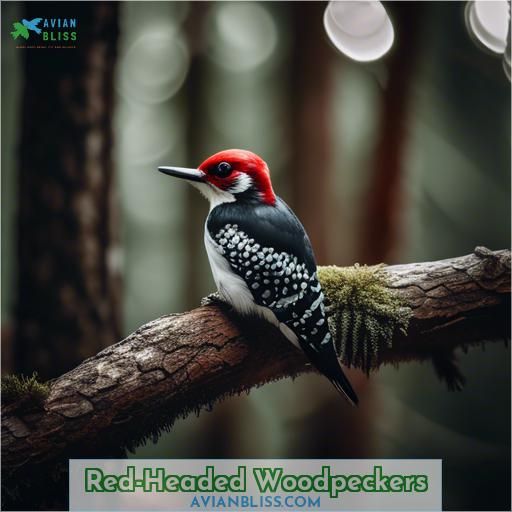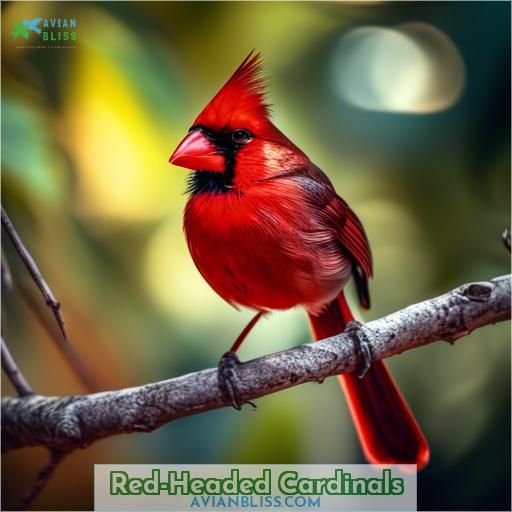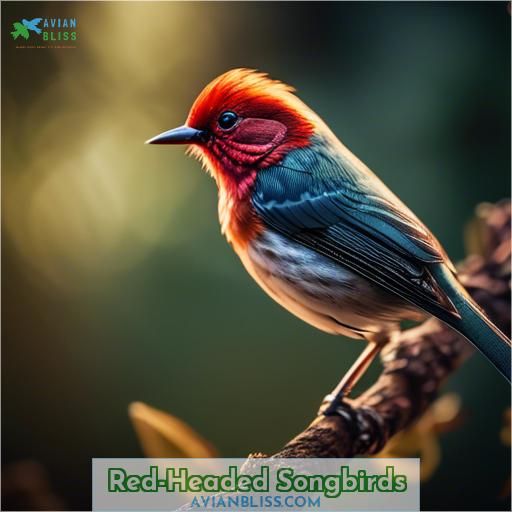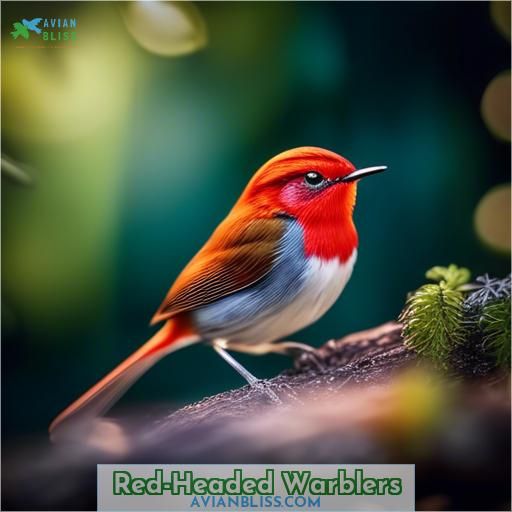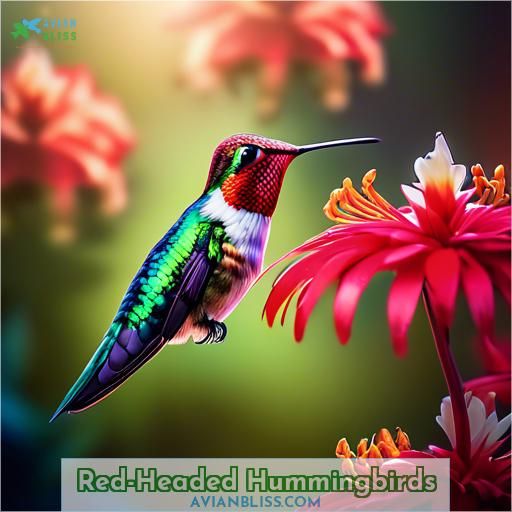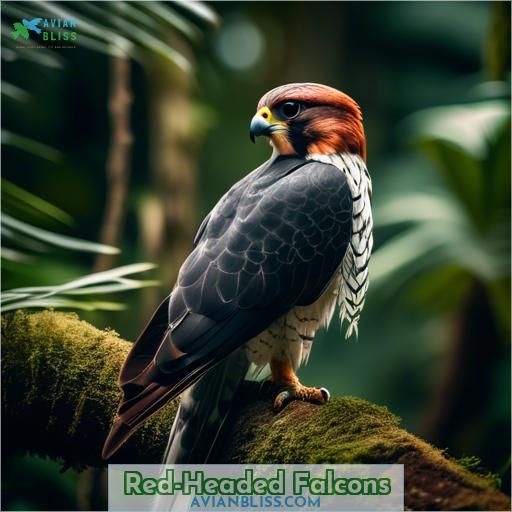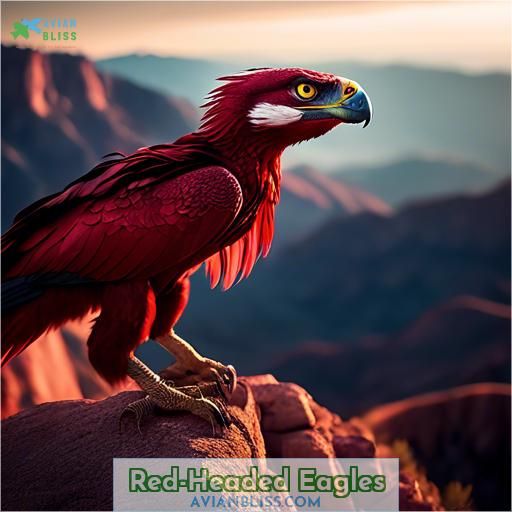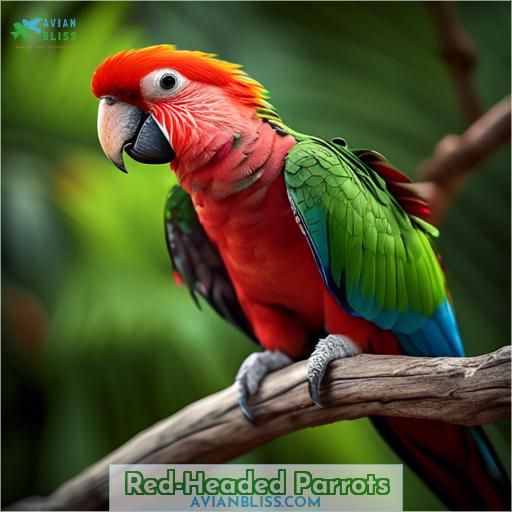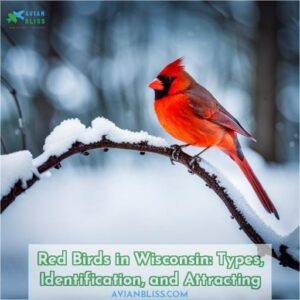This site is supported by our readers. We may earn a commission, at no cost to you, if you purchase through links.
 Immerse yourself in nature’s crimson-crowned wonders as we unveil the captivating world of red-headed birds.
Immerse yourself in nature’s crimson-crowned wonders as we unveil the captivating world of red-headed birds.
These feathered marvels, adorned with fiery plumage, symbolize passion, vitality, and the raw power of the wild.
From woodpeckers’ flaming crests to cardinals’ scarlet crowns, each species boasts a unique allure that ignites our senses and stirs our souls.
Embark on a vibrant journey through this avian realm, where beauty and freedom intertwine, revealing nature’s most striking masterpieces.
Table Of Contents
Key Takeaways
- Red-headed birds are diverse, including woodpeckers, finches, cardinals, songbirds, and waterfowl.
- They exhibit various behaviors, such as foraging for insects, storing food, and defending territories.
- Habitats of red-headed birds range from open woodlands to urban areas, and many species migrate south in winter.
- Conservation efforts are crucial to maintain the balance of nature and protect these birds’ habitats.
Red-Headed Woodpeckers
The Red-headed Woodpecker, with its vibrant red head and striking black and white pattern, is a captivating sight in the world of birds.
These medium-sized woodpeckers, slightly smaller than a Northern Flicker, are known for their powerful bills and short, stiff tails.
They exhibit a unique behavior of foraging for insects in trees, drumming on trees to attract mates, and nesting in cavities.
During winter, they migrate south but are year-round residents in most of their range.
You can find them in deciduous and mixed forests, as well as in parks, orchards, and suburban areas.
Observing these birds dive for food, swim in flocks, and nest in tree cavities or on the ground adds to the allure of their presence in nature.
The Red-headed Woodpecker truly stands out among red-headed birds with its distinctive appearance and fascinating behaviors.
Red-Headed Finches
Transitioning from the exploration of Red-Headed Woodpeckers, let’s now delve into the captivating world of Red-Headed Finches. These vibrant avian beauties boast a striking red head and neck, contrasting with their black back and wings, and white underparts.
As medium-sized songbirds with rounded heads and powerful bills, they exhibit a unique charm in the bird kingdom.
- Red-Headed Beak: House Finches sport a powerful, spike-like bill that aids in foraging for insects.
- Red-Headed Mating: These finches are known for their cheerful courtship songs and social behaviors.
- Red-Headed Diet: House Finches are vegetarians, feeding on seeds, fruit, and tree buds.
- Red-Headed Habitat: They prefer open woodlands, forest edges, parks, orchards, and suburban areas.
Observing these red-headed finches in action is a delightful experience, as they bring a touch of color and melody to our surroundings. Their presence adds a sense of joy and connection to the natural world, making them a cherished sight for bird enthusiasts.
Red-Headed Cardinals
Red-Headed Cardinals: A Splash of Color in the Wild
As we navigate the realm of red-headed birds, it’s time to delve into the vibrant world of red-headed cardinals. These cardinals aren’t only visually striking, but they also possess a unique charm that sets them apart from their counterparts.
Red-headed cardinals, also known as red-crested cardinals, are a sight to behold. Their scarlet plumage is a stark contrast to the black and white barred pattern on their back, and their white underparts provide a perfect backdrop for their fiery red heads.
These birds aren’t only beautiful but also robust, with a size that’s between a red-bellied woodpecker and a red-headed woodpecker.
These cardinals aren’t just a splash of color in the wild; they’re also creatures of habit. They prefer to reside in deciduous and mixed forests, as well as areas with dead or dying trees. Their habitat isn’t limited to forests, though. Red-headed cardinals can also be found in parks, orchards, and suburban areas.
In the realm of behavior, red-headed cardinals aren’t shy. They’re known to forage for insects in trees and defend their territory with a drumming sound on trees.
In the ever-evolving world of birds, red-headed cardinals are a testament to nature’s ability to create beauty in unexpected places. They aren’t just a part of our suite; they’re a vibrant addition to the world of birds, designed to enhance our appreciation for the natural world.
Red-Headed Songbirds
As you delve into the realm of red-headed songbirds, you’ll find a captivating array of species that aren’t only visually stunning but also fascinating in their behavior and habitat preferences.
The Common Redpoll, for instance, is a migratory bird that navigates complexities in its seasonal journey. These birds are designed to enhance your birdwatching experience, as they migrate in flocks, making their presence known in the ever-evolving world of avian beauty.
The Western Tanager, with its rose-red head and black and white barred back, is a sight to behold. These birds are bespoke in their nesting habits, preferring to unveil the secrets of their nests in the heart of deciduous forests.
The Pyrrhuloxia, a cardinal with a red face, is a resident in the southwestern United States. It’s not merely a bird; it’s a part of the ecosystem, preferring to inhabit areas with dead or dying trees.
The House Finch, another resident in the realm of red-headed songbirds, is a forager that feeds on insects. Their feeding strategies are designed to enhance your understanding of the food chain in the wild.
As you explore the world of red-headed songbirds, you’ll find that conservation is a crucial aspect of their existence. From the red-faced warbler to the northern cardinal, each species plays a role in maintaining the balance of nature.
It’s advisable to seek more than just their vibrant colors; delve into their behavior and habitat preferences to truly appreciate their place in the ecosystem.
Red-Headed Waterfowl
Red-Headed Waterfowl: A Dive into the World of Redheads
Red-headed waterfowl, also known as redheads, are a fascinating group of ducks that can be found in various habitats across North America. These birds are known for their vibrant red heads, which contrast sharply with their black necks and chests, gray back and wings, and white belly and undertail.
-
Diving for Food: Redheads are excellent divers and use this trait to obtain food. They primarily feed on aquatic plants and mollusks, as well as insects and small fish. During the breeding season, females increase their animal matter intake to increase their protein levels, and about 77% of their diet is animal related at this time.
-
Mating and Nesting: Redheads have a unique mating ritual. During the reproductive process, the female stands tall and jerks her head up and down, and then holds it erect. The male follows by standing erect and twirling around, showing her his backside. The female may then nip at the male or swim and intersect his path. If a female is focusing her attention on more than one male at a time, the males will attempt to drive each other away. Females begin to nest in the midsummer in marshes and potholes of the prairies, often over water, on islands, or on dry land covered by dense vegetation.
-
Habitat and Range: Redheads breed in the northern prairies of the United States and Canada and the intermountain marshes of the west. They prefer non-forested environments with water areas sufficiently deep to provide permanent and fairly dense emergent vegetation for nesting. Of the diving ducks, redheads are the most common breeders in the United States. Their range extends from the northern prairies to Alaska, and they migrate south in winter, with significant populations wintering in the Laguna Madre of Texas and Mexico.
Red-Headed Warblers
Now, let’s dive into the world of red-headed warblers, where vibrant colors and melodic songs reign supreme. These birds aren’t only visually stunning but also musically gifted, making them a delight to observe.
Red-headed warblers include species such as the Western Tanager and the House Finch. The Western Tanager, with its rose-red head and black and white barred back, is a sight to behold. On the other hand, the House Finch, with its bright red head and white underparts, is a common sight in many backyards.
These birds are meticulously designed to enhance our appreciation for the natural world. They navigate the complexities of their realm with ease, ever-evolving to adapt to their surroundings.
Red-headed warblers exhibit fascinating behavior, such as foraging for insects in trees and drumming on trees to attract mates and defend territory. They’re found in habitats ranging from deciduous forests to suburban areas, making them a versatile and adaptable group of birds.
In the realm of red-headed warblers, there are many secrets to unlock and mysteries to unveil. Whether you’re a seasoned birdwatcher or just starting your journey into the world of birds, these vibrant and lively creatures are sure to captivate and inspire you.
Red-Headed Hummingbirds
After diving into the world of red-headed warblers, let’s zoom into the fascinating lives of red-headed hummingbirds. You’ve seen the vibrant hues of other avians, but nothing quite prepares you for the ruby-throated hummingbird‘s dazzling display.
Imagine a gemstone taking flight, its crimson glow a beacon among the greens of your garden. Not to be outshone, the rufous hummingbird brings a fiery spirit, its orange-red feathers a testament to nature’s palette.
But wait, there’s more! The bee hummingbird, the tiniest bird on the planet, sports a red cap that’s nothing short of miraculous, considering its size. Meanwhile, the flame-throated and stripe-tailed hummingbirds add to this colorful tapestry, each with their unique red accents that captivate and charm.
As you marvel at these avian wonders, remember the cassin’s finch, another feathered friend with a touch of red, reminding us of the endless variety and beauty in our feathered friends. Each bird, a tiny powerhouse, embodies liberation, belonging, and the sheer joy of being alive.
Red-Headed Falcons
Red-headed Falcons are a fascinating group of birds known for their striking appearance and impressive aerial prowess. These birds are medium-sized, with a rounded head and a powerful, spike-like bill.
They’re slightly smaller than a Northern Flicker, measuring between 7.5 and 9.1 inches in length, and weighing between 2.
Their coloration is a vibrant mix of red and black, with a bright red head and neck, black back and wings, and white underparts. The back and wings are adorned with a black and white barred pattern, and the rump is white.
Red-headed Falcons are migratory birds, traveling south in winter to warmer climates. They prefer open woodlands and forest edges, often found in deciduous and mixed forests, areas with dead or dying trees, parks, orchards, and suburban areas.
Their range extends from southern Canada to northern Mexico, making them year-round residents in most of their range.
These birds forage for insects in trees and have a varied diet that includes small birds, rodents, and other prey. They’re known for their dramatic hunting style, often diving at high speeds to capture their prey.
They nest in tree cavities or on the ground, and their breeding season typically lasts from February to May, with females laying 3-4 eggs.
Red-headed Falcons are important predators in their ecosystems, and their populations are categorized as Least Concern in Africa and Near Threatened in Asia. However, deforestation remains a significant threat to their habitat, particularly in areas where palm trees are being destroyed, limiting their nesting and roosting sites.
Red-Headed Eagles
Red-headed Eagles: Majestic Hunters with a Distinctive Look
Red-headed eagles are a sight to behold, with their vibrant red heads standing out against their dark brown bodies. These majestic birds of prey are skilled hunters and are found throughout North America, from Alaska to Mexico.
Let’s delve into the physical characteristics, habitat preference, hunting strategies, and conservation concerns of these impressive creatures.
Physical Characteristics:
Red-headed eagles are large birds, with a wingspan of up to 8.5 feet (2.6 meters) and weighing between 6.5 to 14 pounds (3 to 6.5 kilograms). Mature birds have a snowy white head, neck, and tail, with pale yellow irises and yellow feet and beaks. Juvenile birds are mottled brown with white blotches and don’t obtain the full distinctive plumage of the adults until they’re about five years old.
Habitat Preference:
These eagles are found near large bodies of water and associated grasslands, marshes, rivers, and streams. They’re absent as a regular breeder from the interior of the lower 48 states and are recovering from the effects of habitat destruction and illegal shooting.
Hunting Strategies:
Red-headed eagles are opportunistic foragers but prefer fish as their primary food source. They’re skilled hunters and will wait on a favorite perch for an osprey to return to its nest with a fish in its talons for its own young, then harass the smaller raptor until it’s forced to drop its prey for the eagle to retrieve. They also eat sea birds and ducks or hunt over grasslands and marshes for small mammals such as rabbits, squirrels, prairie dogs, and muskrats.
Conservation Concerns:
Red-headed eagles require an adequate supply of food, nesting sites close to food, and a reasonable degree of freedom from disturbance during nesting periods. They’ve faced threats such as illegal shooting, habitat destruction, lead poisoning, and the catastrophic effects of the pesticide DDT in their prey base. Legal protection began with the Bald Eagle Protection Act of 1940 and continued with the Endangered Species Preservation Act. In 1995, the U.S. Fish and Wildlife Service down-listed Bald Eagles from endangered to threatened in most of the United States.
In conclusion, red-headed eagles are majestic creatures with a distinctive look and a strong presence in the North American avian landscape. Their physical characteristics, habitat preference, hunting strategies, and conservation concerns highlight their importance as a species and the efforts to protect and conserve them.
Red-Headed Parrots
Red-headed parrots, a captivating group of birds, are found in both Africa and South America. These vibrant birds are popular pets due to their intelligence and striking appearance. The Red-crowned Parrot from Mexico is one of the most well-known red-headed parrots, with its distinctive red forehead and crown.
African Grey Parrots are known for their remarkable intelligence and ability to mimic human speech. They’re native to the forests of central and western Africa and are highly sought after as pets. Their popularity has led to their endangerment due to overexploitation for the pet trade.
South American parrots, such as the Scarlet Macaw, are also known for their intelligence and striking appearance. These birds are native to Central and South America and are popular in the pet trade. However, their populations have been threatened by habitat loss and poaching for the pet trade.
Red-headed parrots aren’t only visually appealing but also fascinating creatures. They’re known for their intelligence, which is why they’re often chosen as pets. However, it’s essential to remember that these birds require specialized care and attention, making them more suitable for experienced bird owners.
Frequently Asked Questions (FAQs)
What is the diet of Red-headed Woodpeckers?
You’ll find Red-headed Woodpeckers feasting on insects, nuts, berries, and seeds – a smorgasbord that keeps their beaks busy pecking away.
How do Red-headed Woodpeckers build their nests?
You may think they’re sloppy carpenters, but don’t judge this book by its cover. Red-headed woodpeckers meticulously chip out nest cavities in dead trees or branches, creating perfect homes for their young.
What are the conservation efforts for Red-headed Woodpeckers?
You’ll be glad to know conservationists actively manage forests to create ideal nesting habitats. Leaving dead trees and planting oak savannas benefits these brilliant birds immensely.
How do Red-headed Woodpeckers communicate with each other?
You’ll witness their raucous tchur-tchur calls and vigorous headbobbing as they communicate territory, flirt, and announce danger.
What is the breeding season for Red-headed Woodpeckers?
You’ll find Red-headed Woodpeckers breeding from late April through July. They excavate nest cavities in dead trees or utility poles, laying 4-7 eggs.
Conclusion
Akin to rubies adorning nature’s crown, red-headed birds captivate with their fiery brilliance. Observe their vibrant plumage as they flit amidst foliage, revealing intricate patterns. Whether crimson cardinals, scarlet finches, or vermilion falcons, cherish these avian gems’ radiant presence, symbols of life’s vivacity in feathered form.

